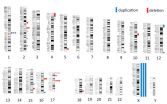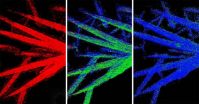(Press-News.org) NEW YORK, NY (April 20, 2015) -- A significant proportion of children with chronic kidney disease (CKD) have unsuspected chromosomal imbalances, including DNA anomalies that have been linked to neurocognitive disorders, according to a new Columbia University Medical Center (CUMC) study. The findings suggest that routine genetic screening of children with CKD could lead to earlier and more precise diagnoses, as well as to more personalized monitoring, prevention, and treatment. Details of the study were published today in the online issue of the Journal of Clinical investigation.
"With conventional clinical findings, we often cannot determine the exact cause of CKD in children," said study leader Ali G. Gharavi, MD, professor of medicine and chief of the Division of Nephrology at CUMC. "However, our study shows that using a readily available genetic screening tool called chromosomal microarray analysis, it's possible in many cases to reach a more precise diagnosis and uncover information that can help define a patient's risk for other disorders, such as autism or diabetes."
About 13 percent of Americans are affected by CKD. The disease is particularly serious in children, often leading to complications like high blood pressure, heart disease, neurodevelopmental problems, and behavioral deficits. Roughly half of all cases of CKD in children are caused by birth defects, such as an underdeveloped or missing kidney. CKD can also result from hereditary diseases, infection, toxic exposures, and autoimmune disorders. In many patients, the cause cannot be determined.
Dr. Gharavi, together with lead author Miguel Verbistky, PhD, associate research scientist, and their colleagues, hypothesized that copy number variations (CNVs)--gain or loss of bits of DNA--might provide insights into the cause of CKD in children. The team performed chromosomal microarray analyses of 419 children enrolled in the Chronic Kidney Disease in Children (CKiD) Prospective Cohort Study to determine the prevalence of disease-causing CNVs among various categories of pediatric CKD. The data were compared with genomic data on 21,575 healthy pediatric and adult controls.
The researchers found significant CNVs in 31, or 7.4 percent, of the 419 children with CKD (roughly ten-fold the percentage seen in the controls). The most frequent CNVs were deletions in the HNF1B gene. Loss of HNF1B function is associated with renal cysts and diabetes syndrome, which increases one's susceptibility to kidney malformations, diabetes, and cognitive disorders, among other conditions. Many of the other CNVs that were uncovered were associated with developmental delays, intellectual disabilities, and seizure disorders.
Of the 31 children with significant CNVs, 28 had genetic diagnoses that differed from the clinical diagnosis or that added information that would have altered the care of the patient, according to the study.
"Because kidney problems can be detected early by blood tests, or even by prenatal imaging studies, this offers the opportunity for screening and detecting genomic imbalances before other complications, such as developmental delay, become clinically apparent," said Dr. Verbistky.
"Our findings should change clinical practice," said Dr. Gharavi. "Routine genetic screening of kids with CKD would not only improve diagnosis but also help identify those at risk for complications like diabetes and subclinical seizures, which benefit from early detection and treatment."
The findings also shed light on why children with CKD tend to perform less well in school than their peers. "The prevailing hypothesis," said Dr. Gharavi, "is that their poor academic performance is due simply to impaired kidney function and the burden of having a chronic illness. But our data suggest that these kids may be underperforming because of an underlying genetic lesion that affects both kidney and neurologic function. If so, it's important that we identify these potential problems and intervene as early as possible."
INFORMATION:
The paper is titled, "Chromosomal Microarrays for the Diagnosis of Pediatric Chronic Kidney Disease." The other contributors are: Miguel Verbitsky (CUMC), Simone Sanna-Cherchi (CUMC), David A. Fasel (CUMC), Brynn Levy (CUMC), Krzysztof Kiryluk (CUMC), Matthias Wuttke (University of Freiburg, Freiburg, Germany), Alison G. Abraham (Johns Hopkins Bloomberg School of Public Health, Baltimore, MD), Frederick Kaskel (Albert Einstein College of Medicine, Bronx, NY), Anna Köttgen (University of Freiburg and Johns Hopkins Bloomberg School of Public Health), Bradley A. Warady (Children's Mercy Hospital, Kansas City, MO), Susan L. Furth (University of Pennsylvania, Children's Hospital of Philadelphia, Philadelphia, PA), and Craig S. Wong (University of New Mexico Children's Hospital, Albuquerque, NM).
The study was funded by grants from the National Institutes of Health (RO1DK082394, 1R01DK080099, 1U54DK104309, and RO1DK082394).
The authors declare no financial or other conflicts of interest.
Columbia University Medical Center provides international leadership in basic, preclinical, and clinical research; medical and health sciences education; and patient care. The medical center trains future leaders and includes the dedicated work of many physicians, scientists, public health professionals, dentists, and nurses at the College of Physicians and Surgeons, the Mailman School of Public Health, the College of Dental Medicine, the School of Nursing, the biomedical departments of the Graduate School of Arts and Sciences, and allied research centers and institutions. Columbia University Medical Center is home to the largest medical research enterprise in New York City and State and one of the largest faculty medical practices in the Northeast. For more information, visit cumc.columbia.edu or columbiadoctors.org.
Every year, more than 120 million prescriptions are written worldwide for thiazide drugs, a group of salt-lowering medicines used to treat high blood pressure. These drugs are often work very well, and over decades have saved hundreds of thousands of lives.
But in some patients, thiazides are not effective; in others they lower blood pressure for a while and then stop working. The reasons for this have remained a mystery. Now, a new study by researchers at the University of Maryland School of Medicine (UM SOM) has revealed a key mechanism for this failure.
Paul Welling, ...
Following a first seizure, physicians should discuss with patients whether it is appropriate to prescribe medication to reduce risk of another seizure, according to new guidelines released at the American Academy of Neurology meeting.
The guidelines, which were a collaboration of authors at several North American medical institutions including NYU Langone Medical Center, found adults who experience a first seizure may have risk of another seizure that's greatest within the first two years. Adults with prior neurological trauma, abnormalities on EEGs and imaging may be ...
Access to high-quality medicine is a basic human right, but over four billion people live in countries where many medications are substandard or fake. Marya Lieberman of the Department of Chemistry and Biochemistry at the University of Notre Dame and Abigail Weaver a postdoctoral associate in the University's Department of Civil Engineering and Environmental and Earth Sciences took up the challenge of how people in developing countries could detect low quality antimalarial drugs without expensive equipment and without handling dangerous chemicals.
The solution they ...
MADISON, Wis. -- In a move that could improve the energy storage of everything from portable electronics to electric microgrids, University of Wisconsin-Madison and Brookhaven National Laboratory researchers have developed a novel X-ray imaging technique to visualize and study the electrochemical reactions in lithium-ion rechargeable batteries containing a new type of material, iron fluoride.
"Iron fluoride has the potential to triple the amount of energy a conventional lithium-ion battery can store," says Song Jin, a UW-Madison professor of chemistry and Wisconsin Energy ...
Toronto, CANADA - Imagine living a healthy, normal life without the ability to re-experience in your mind personal events from your past. You have learned details about past episodes from your life and can recite these to family and friends, but you can't mentally travel back in time to imagine yourself in any of them.
Cognitive scientists from Baycrest Health Sciences' Rotman Research Institute in Toronto had a rare opportunity to examine three middle-aged adults (two from the U.S., the other from the U.K.) who essentially live their lives in the "third person" because ...
Tryptophan is an amino acid, one of the building blocks of proteins. It is used extensively to study how proteins change their 3D structure, and also how they interact with other proteins and molecules. This is studied with a fluorescence technique called FRET, which measures the transfer of energy from tryptophan to another molecule. But in some cases, FRET data could be distorted because tryptophan transfers an electron instead of energy. Using a unique spectroscopic technique, scientists at EPFL have now confirmed for the first time that this is indeed the case. The ...
CAMBRIDGE, Mass. (April 20, 2015) - A novel approach that allows real-time imaging of the immune system's response to the presence of tumors--without the need for blood draws or invasive biopsies--offers a potential breakthrough both in diagnostics and in the ability to monitor efficacy of cancer therapies.
The method, developed in the lab of Whitehead Institute Member Hidde Ploegh and reported online this week in the Proceedings of the National Academy of Sciences (PNAS), harnesses the imaging power of positron emission tomography (PET), which is normally used to monitor ...
PHILADELPHIA, April 20, 2015 - New findings hidden within the complex machinery behind the vicious cycle of chronic inflammation and cancer are presented today by researchers from the University of Pittsburgh Cancer Institute, partner with UPMC Cancer Center, at the American Association for Cancer Research (AACR) Annual Meeting in Philadelphia.
The research is funded by the National Institutes of Health (NIH) and Fondazione RiMED, of Palermo, Italy.
Inflammation is an important immune system tool that helps the body rid itself of foreign invaders, such as bacteria. ...
New analysis of world-famous 3.46 billion-year-old rocks by researchers from the University of Bristol, the University of Oxford and UWA (the University of Western Australia) is set to finally resolve a long running evolutionary controversy.
The new research, published this week in Proceedings of the National Academy of Sciences USA, shows that structures once thought to be Earth's oldest microfossils do not compare with younger fossil candidates but have, instead, the character of peculiarly shaped minerals.
In 1993, US scientist Bill Schopf described tiny carbon-rich ...
MADISON, Wis. -- If your home country is historically heterogeneous and you know it, crack a smile.
People who live in countries built on centuries of migration from a wide range of other countries are more emotionally expressive than people in more insular cultures, according to research led by University of Wisconsin-Madison psychology Professor Paula Niedenthal.
The study, published this week in the Proceedings of the National Academy of Sciences, compared several social and demographic variables to the way people describe the rules for displaying emotion in dozens ...


